Importance of Financial Management for Business Management with Foundation
VerifiedAdded on 2023/06/05
|13
|2866
|189
AI Summary
This report covers the concept and importance of financial management, financial statements, financial ratios, and strategies for improving financial performance. It explains the procurement and utilization of funds, and the importance of financial management in future planning, improving financial performance, and reducing production costs.
Contribute Materials
Your contribution can guide someone’s learning journey. Share your
documents today.
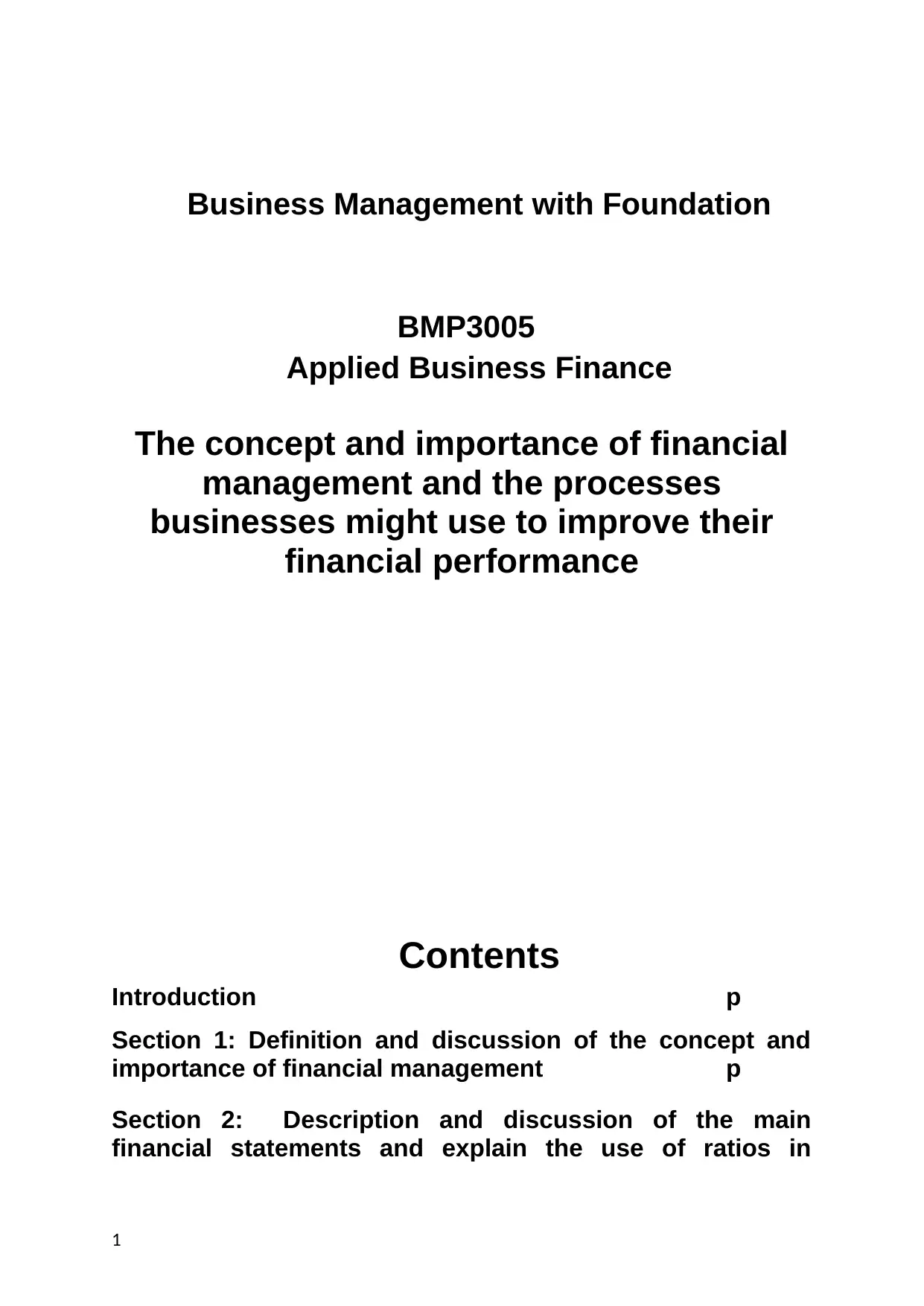
Business Management with Foundation
BMP3005
Applied Business Finance
The concept and importance of financial
management and the processes
businesses might use to improve their
financial performance
Contents
Introduction p
Section 1: Definition and discussion of the concept and
importance of financial management p
Section 2: Description and discussion of the main
financial statements and explain the use of ratios in
1
BMP3005
Applied Business Finance
The concept and importance of financial
management and the processes
businesses might use to improve their
financial performance
Contents
Introduction p
Section 1: Definition and discussion of the concept and
importance of financial management p
Section 2: Description and discussion of the main
financial statements and explain the use of ratios in
1
Secure Best Marks with AI Grader
Need help grading? Try our AI Grader for instant feedback on your assignments.
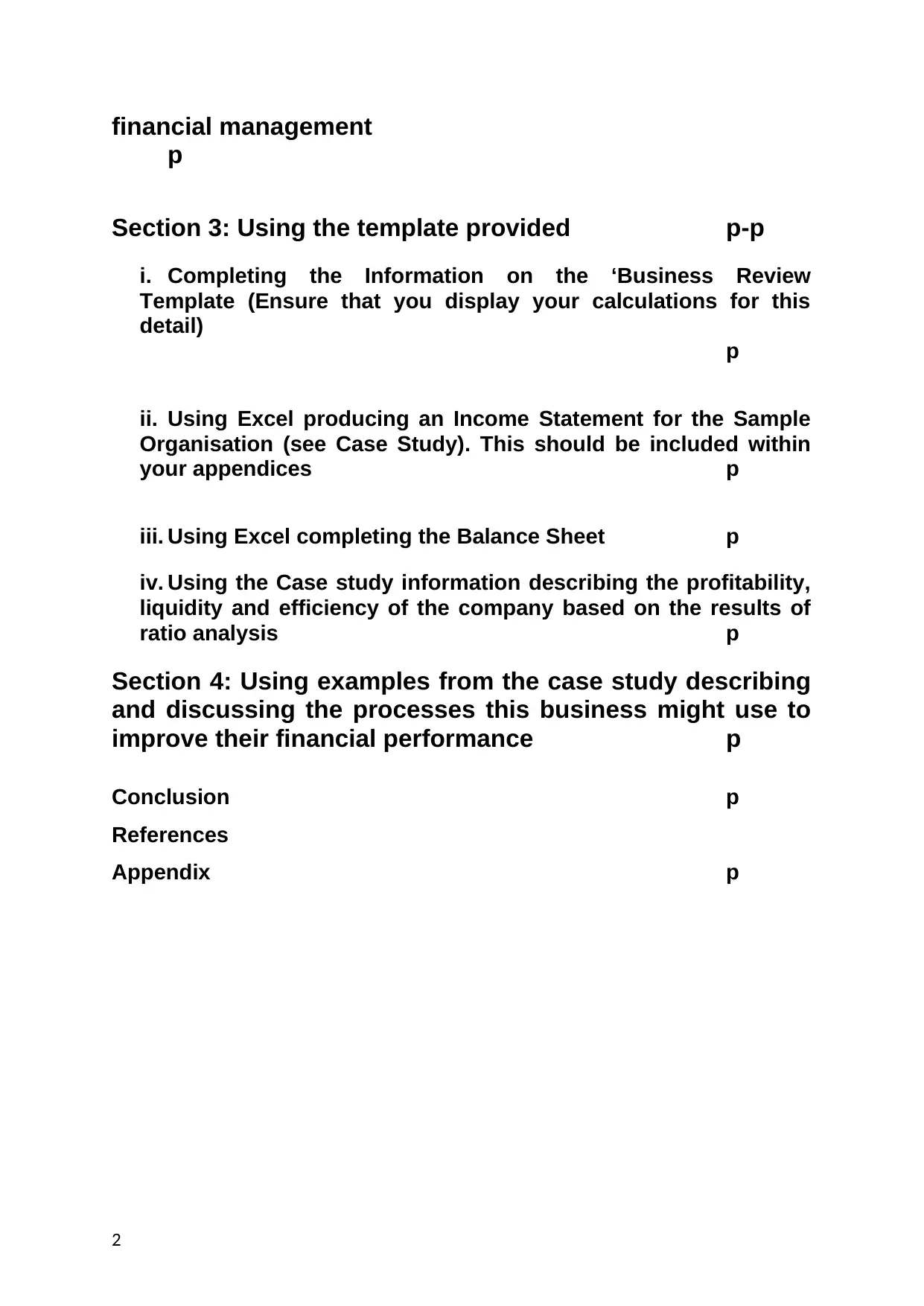
financial management
p
Section 3: Using the template provided p-p
i. Completing the Information on the ‘Business Review
Template (Ensure that you display your calculations for this
detail)
p
ii. Using Excel producing an Income Statement for the Sample
Organisation (see Case Study). This should be included within
your appendices p
iii. Using Excel completing the Balance Sheet p
iv. Using the Case study information describing the profitability,
liquidity and efficiency of the company based on the results of
ratio analysis p
Section 4: Using examples from the case study describing
and discussing the processes this business might use to
improve their financial performance p
Conclusion p
References
Appendix p
2
p
Section 3: Using the template provided p-p
i. Completing the Information on the ‘Business Review
Template (Ensure that you display your calculations for this
detail)
p
ii. Using Excel producing an Income Statement for the Sample
Organisation (see Case Study). This should be included within
your appendices p
iii. Using Excel completing the Balance Sheet p
iv. Using the Case study information describing the profitability,
liquidity and efficiency of the company based on the results of
ratio analysis p
Section 4: Using examples from the case study describing
and discussing the processes this business might use to
improve their financial performance p
Conclusion p
References
Appendix p
2
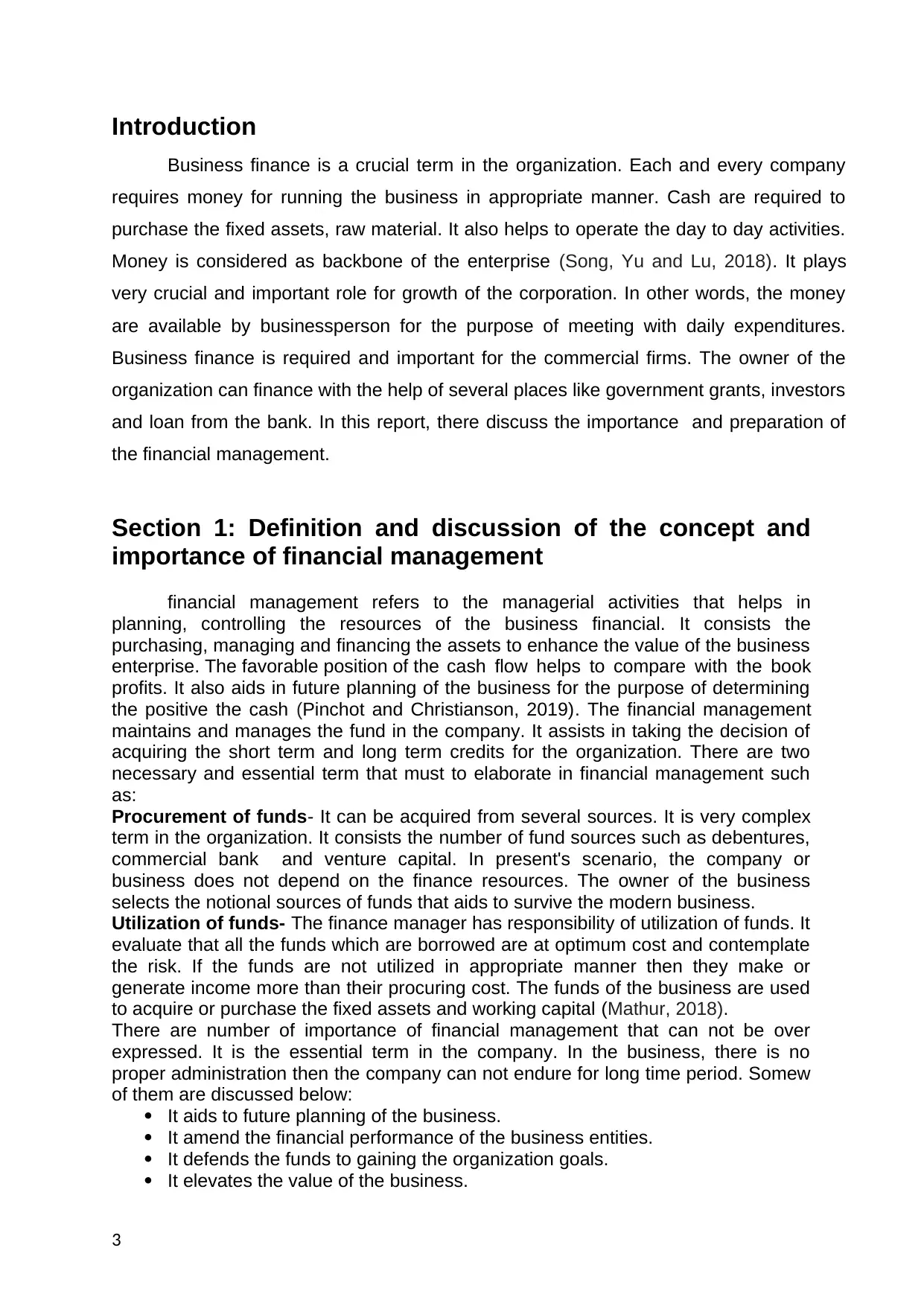
Introduction
Business finance is a crucial term in the organization. Each and every company
requires money for running the business in appropriate manner. Cash are required to
purchase the fixed assets, raw material. It also helps to operate the day to day activities.
Money is considered as backbone of the enterprise (Song, Yu and Lu, 2018). It plays
very crucial and important role for growth of the corporation. In other words, the money
are available by businessperson for the purpose of meeting with daily expenditures.
Business finance is required and important for the commercial firms. The owner of the
organization can finance with the help of several places like government grants, investors
and loan from the bank. In this report, there discuss the importance and preparation of
the financial management.
Section 1: Definition and discussion of the concept and
importance of financial management
financial management refers to the managerial activities that helps in
planning, controlling the resources of the business financial. It consists the
purchasing, managing and financing the assets to enhance the value of the business
enterprise. The favorable position of the cash flow helps to compare with the book
profits. It also aids in future planning of the business for the purpose of determining
the positive the cash (Pinchot and Christianson, 2019). The financial management
maintains and manages the fund in the company. It assists in taking the decision of
acquiring the short term and long term credits for the organization. There are two
necessary and essential term that must to elaborate in financial management such
as:
Procurement of funds- It can be acquired from several sources. It is very complex
term in the organization. It consists the number of fund sources such as debentures,
commercial bank and venture capital. In present's scenario, the company or
business does not depend on the finance resources. The owner of the business
selects the notional sources of funds that aids to survive the modern business.
Utilization of funds- The finance manager has responsibility of utilization of funds. It
evaluate that all the funds which are borrowed are at optimum cost and contemplate
the risk. If the funds are not utilized in appropriate manner then they make or
generate income more than their procuring cost. The funds of the business are used
to acquire or purchase the fixed assets and working capital (Mathur, 2018).
There are number of importance of financial management that can not be over
expressed. It is the essential term in the company. In the business, there is no
proper administration then the company can not endure for long time period. Somew
of them are discussed below:
It aids to future planning of the business.
It amend the financial performance of the business entities.
It defends the funds to gaining the organization goals.
It elevates the value of the business.
3
Business finance is a crucial term in the organization. Each and every company
requires money for running the business in appropriate manner. Cash are required to
purchase the fixed assets, raw material. It also helps to operate the day to day activities.
Money is considered as backbone of the enterprise (Song, Yu and Lu, 2018). It plays
very crucial and important role for growth of the corporation. In other words, the money
are available by businessperson for the purpose of meeting with daily expenditures.
Business finance is required and important for the commercial firms. The owner of the
organization can finance with the help of several places like government grants, investors
and loan from the bank. In this report, there discuss the importance and preparation of
the financial management.
Section 1: Definition and discussion of the concept and
importance of financial management
financial management refers to the managerial activities that helps in
planning, controlling the resources of the business financial. It consists the
purchasing, managing and financing the assets to enhance the value of the business
enterprise. The favorable position of the cash flow helps to compare with the book
profits. It also aids in future planning of the business for the purpose of determining
the positive the cash (Pinchot and Christianson, 2019). The financial management
maintains and manages the fund in the company. It assists in taking the decision of
acquiring the short term and long term credits for the organization. There are two
necessary and essential term that must to elaborate in financial management such
as:
Procurement of funds- It can be acquired from several sources. It is very complex
term in the organization. It consists the number of fund sources such as debentures,
commercial bank and venture capital. In present's scenario, the company or
business does not depend on the finance resources. The owner of the business
selects the notional sources of funds that aids to survive the modern business.
Utilization of funds- The finance manager has responsibility of utilization of funds. It
evaluate that all the funds which are borrowed are at optimum cost and contemplate
the risk. If the funds are not utilized in appropriate manner then they make or
generate income more than their procuring cost. The funds of the business are used
to acquire or purchase the fixed assets and working capital (Mathur, 2018).
There are number of importance of financial management that can not be over
expressed. It is the essential term in the company. In the business, there is no
proper administration then the company can not endure for long time period. Somew
of them are discussed below:
It aids to future planning of the business.
It amend the financial performance of the business entities.
It defends the funds to gaining the organization goals.
It elevates the value of the business.
3
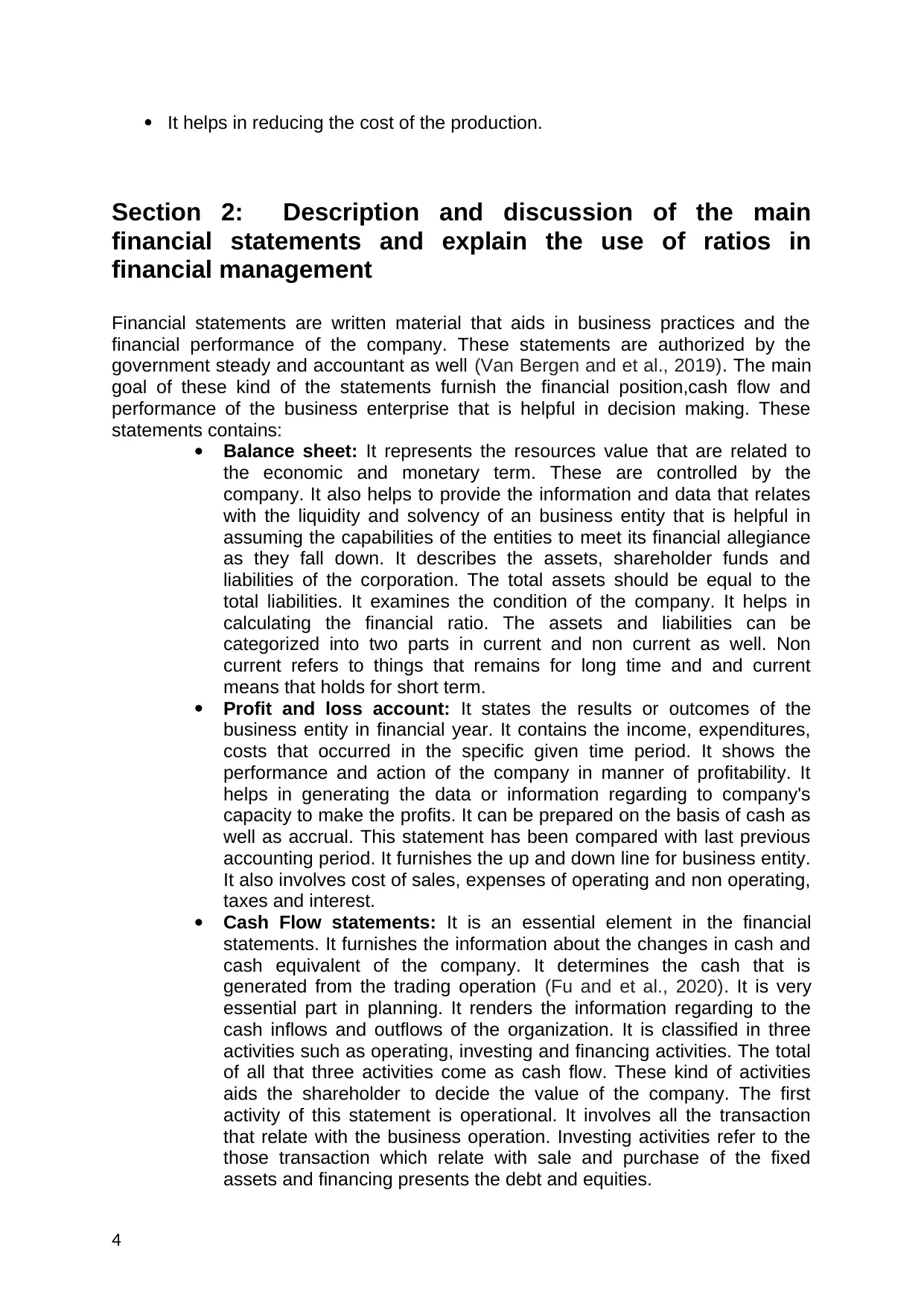
It helps in reducing the cost of the production.
Section 2: Description and discussion of the main
financial statements and explain the use of ratios in
financial management
Financial statements are written material that aids in business practices and the
financial performance of the company. These statements are authorized by the
government steady and accountant as well (Van Bergen and et al., 2019). The main
goal of these kind of the statements furnish the financial position,cash flow and
performance of the business enterprise that is helpful in decision making. These
statements contains:
Balance sheet: It represents the resources value that are related to
the economic and monetary term. These are controlled by the
company. It also helps to provide the information and data that relates
with the liquidity and solvency of an business entity that is helpful in
assuming the capabilities of the entities to meet its financial allegiance
as they fall down. It describes the assets, shareholder funds and
liabilities of the corporation. The total assets should be equal to the
total liabilities. It examines the condition of the company. It helps in
calculating the financial ratio. The assets and liabilities can be
categorized into two parts in current and non current as well. Non
current refers to things that remains for long time and and current
means that holds for short term.
Profit and loss account: It states the results or outcomes of the
business entity in financial year. It contains the income, expenditures,
costs that occurred in the specific given time period. It shows the
performance and action of the company in manner of profitability. It
helps in generating the data or information regarding to company's
capacity to make the profits. It can be prepared on the basis of cash as
well as accrual. This statement has been compared with last previous
accounting period. It furnishes the up and down line for business entity.
It also involves cost of sales, expenses of operating and non operating,
taxes and interest.
Cash Flow statements: It is an essential element in the financial
statements. It furnishes the information about the changes in cash and
cash equivalent of the company. It determines the cash that is
generated from the trading operation (Fu and et al., 2020). It is very
essential part in planning. It renders the information regarding to the
cash inflows and outflows of the organization. It is classified in three
activities such as operating, investing and financing activities. The total
of all that three activities come as cash flow. These kind of activities
aids the shareholder to decide the value of the company. The first
activity of this statement is operational. It involves all the transaction
that relate with the business operation. Investing activities refer to the
those transaction which relate with sale and purchase of the fixed
assets and financing presents the debt and equities.
4
Section 2: Description and discussion of the main
financial statements and explain the use of ratios in
financial management
Financial statements are written material that aids in business practices and the
financial performance of the company. These statements are authorized by the
government steady and accountant as well (Van Bergen and et al., 2019). The main
goal of these kind of the statements furnish the financial position,cash flow and
performance of the business enterprise that is helpful in decision making. These
statements contains:
Balance sheet: It represents the resources value that are related to
the economic and monetary term. These are controlled by the
company. It also helps to provide the information and data that relates
with the liquidity and solvency of an business entity that is helpful in
assuming the capabilities of the entities to meet its financial allegiance
as they fall down. It describes the assets, shareholder funds and
liabilities of the corporation. The total assets should be equal to the
total liabilities. It examines the condition of the company. It helps in
calculating the financial ratio. The assets and liabilities can be
categorized into two parts in current and non current as well. Non
current refers to things that remains for long time and and current
means that holds for short term.
Profit and loss account: It states the results or outcomes of the
business entity in financial year. It contains the income, expenditures,
costs that occurred in the specific given time period. It shows the
performance and action of the company in manner of profitability. It
helps in generating the data or information regarding to company's
capacity to make the profits. It can be prepared on the basis of cash as
well as accrual. This statement has been compared with last previous
accounting period. It furnishes the up and down line for business entity.
It also involves cost of sales, expenses of operating and non operating,
taxes and interest.
Cash Flow statements: It is an essential element in the financial
statements. It furnishes the information about the changes in cash and
cash equivalent of the company. It determines the cash that is
generated from the trading operation (Fu and et al., 2020). It is very
essential part in planning. It renders the information regarding to the
cash inflows and outflows of the organization. It is classified in three
activities such as operating, investing and financing activities. The total
of all that three activities come as cash flow. These kind of activities
aids the shareholder to decide the value of the company. The first
activity of this statement is operational. It involves all the transaction
that relate with the business operation. Investing activities refer to the
those transaction which relate with sale and purchase of the fixed
assets and financing presents the debt and equities.
4
Secure Best Marks with AI Grader
Need help grading? Try our AI Grader for instant feedback on your assignments.
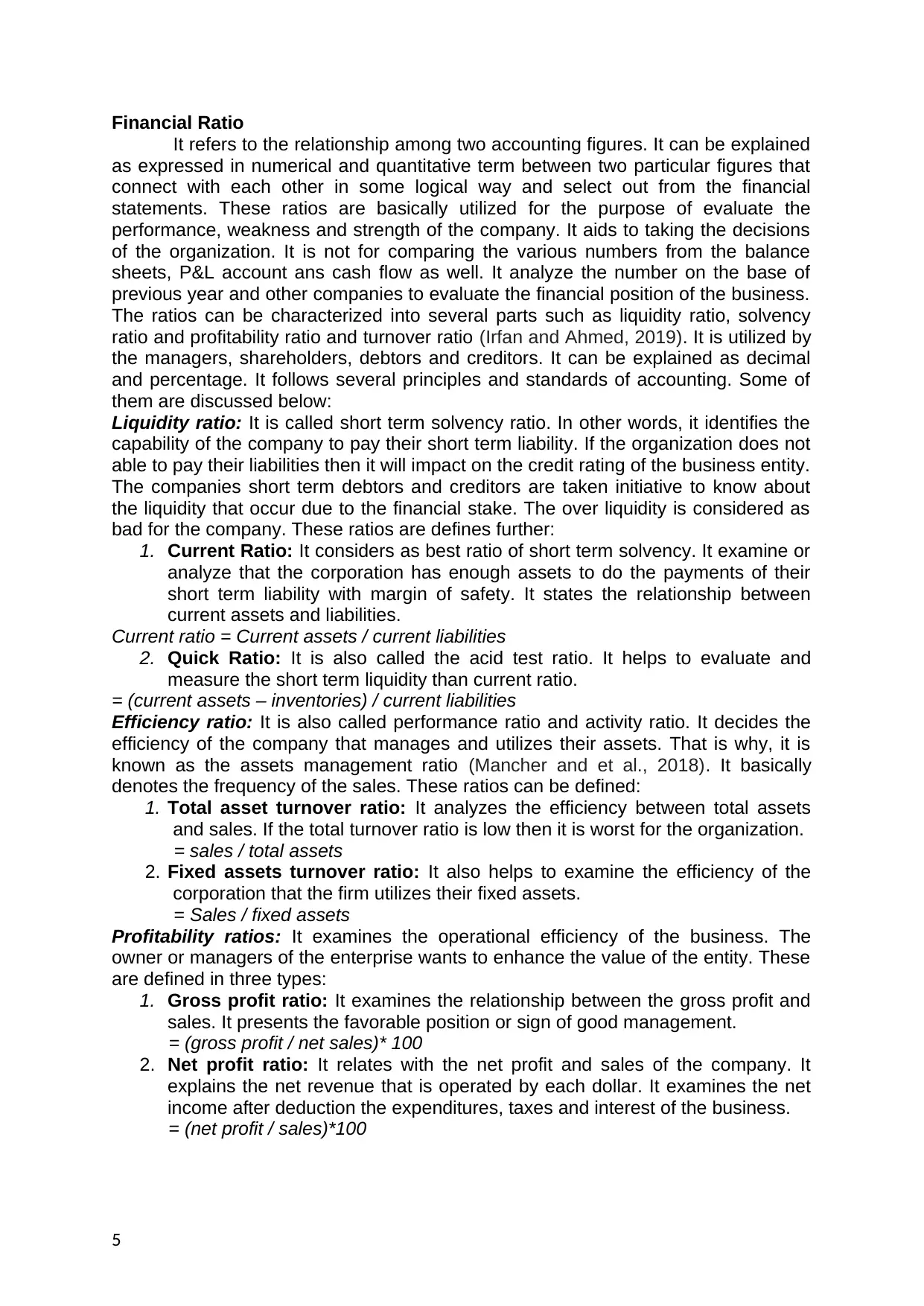
Financial Ratio
It refers to the relationship among two accounting figures. It can be explained
as expressed in numerical and quantitative term between two particular figures that
connect with each other in some logical way and select out from the financial
statements. These ratios are basically utilized for the purpose of evaluate the
performance, weakness and strength of the company. It aids to taking the decisions
of the organization. It is not for comparing the various numbers from the balance
sheets, P&L account ans cash flow as well. It analyze the number on the base of
previous year and other companies to evaluate the financial position of the business.
The ratios can be characterized into several parts such as liquidity ratio, solvency
ratio and profitability ratio and turnover ratio (Irfan and Ahmed, 2019). It is utilized by
the managers, shareholders, debtors and creditors. It can be explained as decimal
and percentage. It follows several principles and standards of accounting. Some of
them are discussed below:
Liquidity ratio: It is called short term solvency ratio. In other words, it identifies the
capability of the company to pay their short term liability. If the organization does not
able to pay their liabilities then it will impact on the credit rating of the business entity.
The companies short term debtors and creditors are taken initiative to know about
the liquidity that occur due to the financial stake. The over liquidity is considered as
bad for the company. These ratios are defines further:
1. Current Ratio: It considers as best ratio of short term solvency. It examine or
analyze that the corporation has enough assets to do the payments of their
short term liability with margin of safety. It states the relationship between
current assets and liabilities.
Current ratio = Current assets / current liabilities
2. Quick Ratio: It is also called the acid test ratio. It helps to evaluate and
measure the short term liquidity than current ratio.
= (current assets – inventories) / current liabilities
Efficiency ratio: It is also called performance ratio and activity ratio. It decides the
efficiency of the company that manages and utilizes their assets. That is why, it is
known as the assets management ratio (Mancher and et al., 2018). It basically
denotes the frequency of the sales. These ratios can be defined:
1. Total asset turnover ratio: It analyzes the efficiency between total assets
and sales. If the total turnover ratio is low then it is worst for the organization.
= sales / total assets
2. Fixed assets turnover ratio: It also helps to examine the efficiency of the
corporation that the firm utilizes their fixed assets.
= Sales / fixed assets
Profitability ratios: It examines the operational efficiency of the business. The
owner or managers of the enterprise wants to enhance the value of the entity. These
are defined in three types:
1. Gross profit ratio: It examines the relationship between the gross profit and
sales. It presents the favorable position or sign of good management.
= (gross profit / net sales)* 100
2. Net profit ratio: It relates with the net profit and sales of the company. It
explains the net revenue that is operated by each dollar. It examines the net
income after deduction the expenditures, taxes and interest of the business.
= (net profit / sales)*100
5
It refers to the relationship among two accounting figures. It can be explained
as expressed in numerical and quantitative term between two particular figures that
connect with each other in some logical way and select out from the financial
statements. These ratios are basically utilized for the purpose of evaluate the
performance, weakness and strength of the company. It aids to taking the decisions
of the organization. It is not for comparing the various numbers from the balance
sheets, P&L account ans cash flow as well. It analyze the number on the base of
previous year and other companies to evaluate the financial position of the business.
The ratios can be characterized into several parts such as liquidity ratio, solvency
ratio and profitability ratio and turnover ratio (Irfan and Ahmed, 2019). It is utilized by
the managers, shareholders, debtors and creditors. It can be explained as decimal
and percentage. It follows several principles and standards of accounting. Some of
them are discussed below:
Liquidity ratio: It is called short term solvency ratio. In other words, it identifies the
capability of the company to pay their short term liability. If the organization does not
able to pay their liabilities then it will impact on the credit rating of the business entity.
The companies short term debtors and creditors are taken initiative to know about
the liquidity that occur due to the financial stake. The over liquidity is considered as
bad for the company. These ratios are defines further:
1. Current Ratio: It considers as best ratio of short term solvency. It examine or
analyze that the corporation has enough assets to do the payments of their
short term liability with margin of safety. It states the relationship between
current assets and liabilities.
Current ratio = Current assets / current liabilities
2. Quick Ratio: It is also called the acid test ratio. It helps to evaluate and
measure the short term liquidity than current ratio.
= (current assets – inventories) / current liabilities
Efficiency ratio: It is also called performance ratio and activity ratio. It decides the
efficiency of the company that manages and utilizes their assets. That is why, it is
known as the assets management ratio (Mancher and et al., 2018). It basically
denotes the frequency of the sales. These ratios can be defined:
1. Total asset turnover ratio: It analyzes the efficiency between total assets
and sales. If the total turnover ratio is low then it is worst for the organization.
= sales / total assets
2. Fixed assets turnover ratio: It also helps to examine the efficiency of the
corporation that the firm utilizes their fixed assets.
= Sales / fixed assets
Profitability ratios: It examines the operational efficiency of the business. The
owner or managers of the enterprise wants to enhance the value of the entity. These
are defined in three types:
1. Gross profit ratio: It examines the relationship between the gross profit and
sales. It presents the favorable position or sign of good management.
= (gross profit / net sales)* 100
2. Net profit ratio: It relates with the net profit and sales of the company. It
explains the net revenue that is operated by each dollar. It examines the net
income after deduction the expenditures, taxes and interest of the business.
= (net profit / sales)*100
5
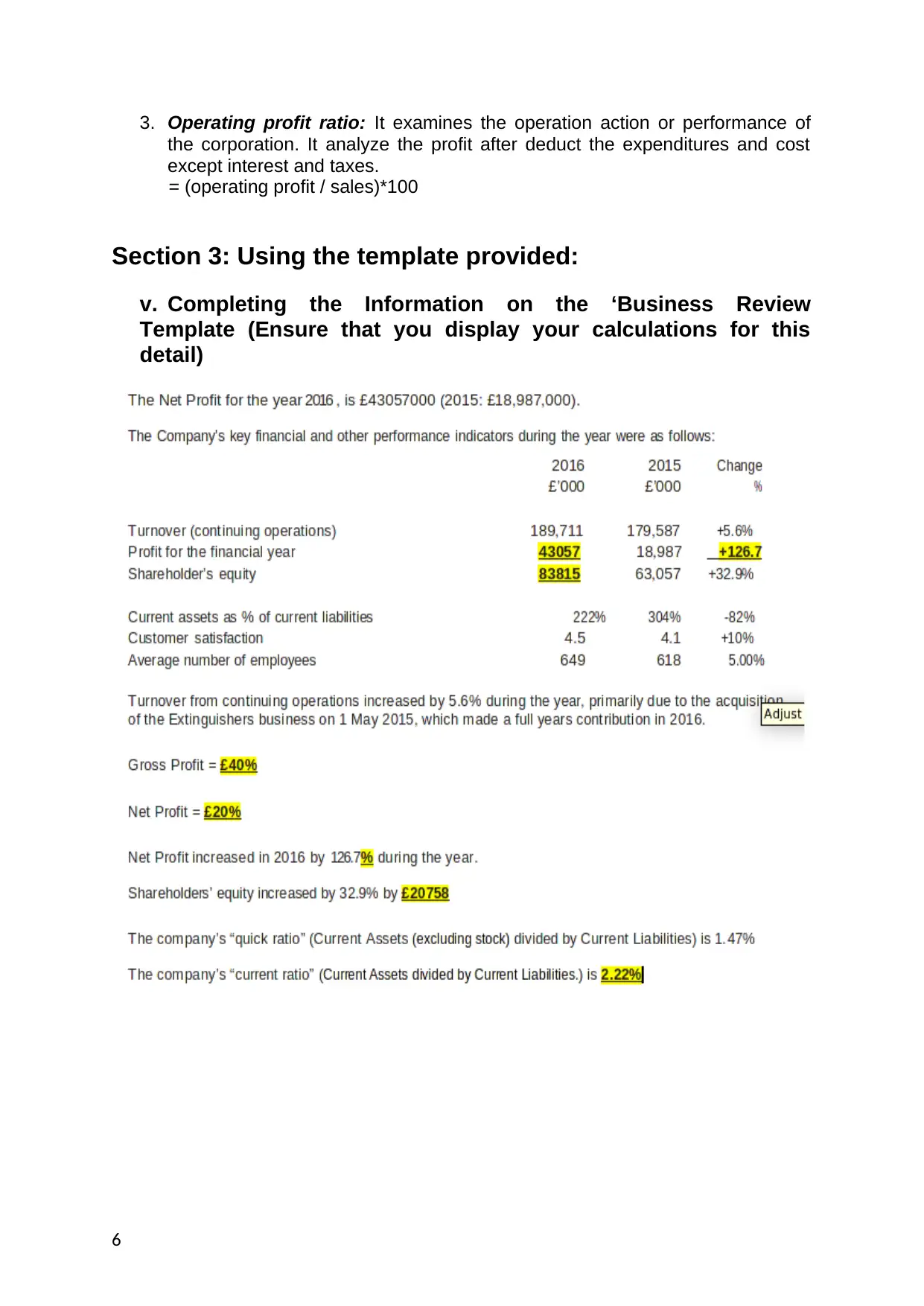
3. Operating profit ratio: It examines the operation action or performance of
the corporation. It analyze the profit after deduct the expenditures and cost
except interest and taxes.
= (operating profit / sales)*100
Section 3: Using the template provided:
v. Completing the Information on the ‘Business Review
Template (Ensure that you display your calculations for this
detail)
6
the corporation. It analyze the profit after deduct the expenditures and cost
except interest and taxes.
= (operating profit / sales)*100
Section 3: Using the template provided:
v. Completing the Information on the ‘Business Review
Template (Ensure that you display your calculations for this
detail)
6
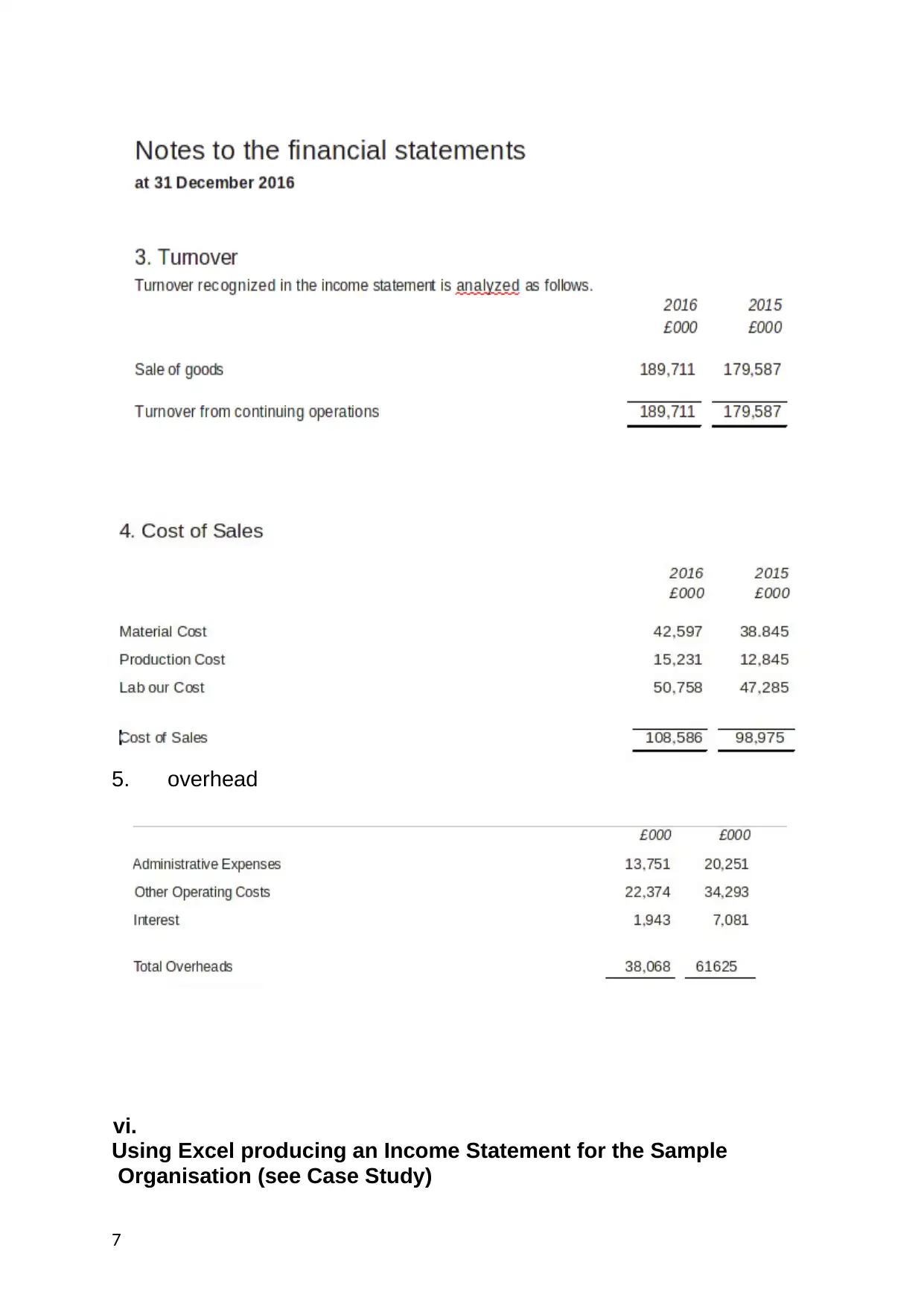
5. overhead
vi.
Using Excel producing an Income Statement for the Sample
Organisation (see Case Study)
7
vi.
Using Excel producing an Income Statement for the Sample
Organisation (see Case Study)
7
Paraphrase This Document
Need a fresh take? Get an instant paraphrase of this document with our AI Paraphraser
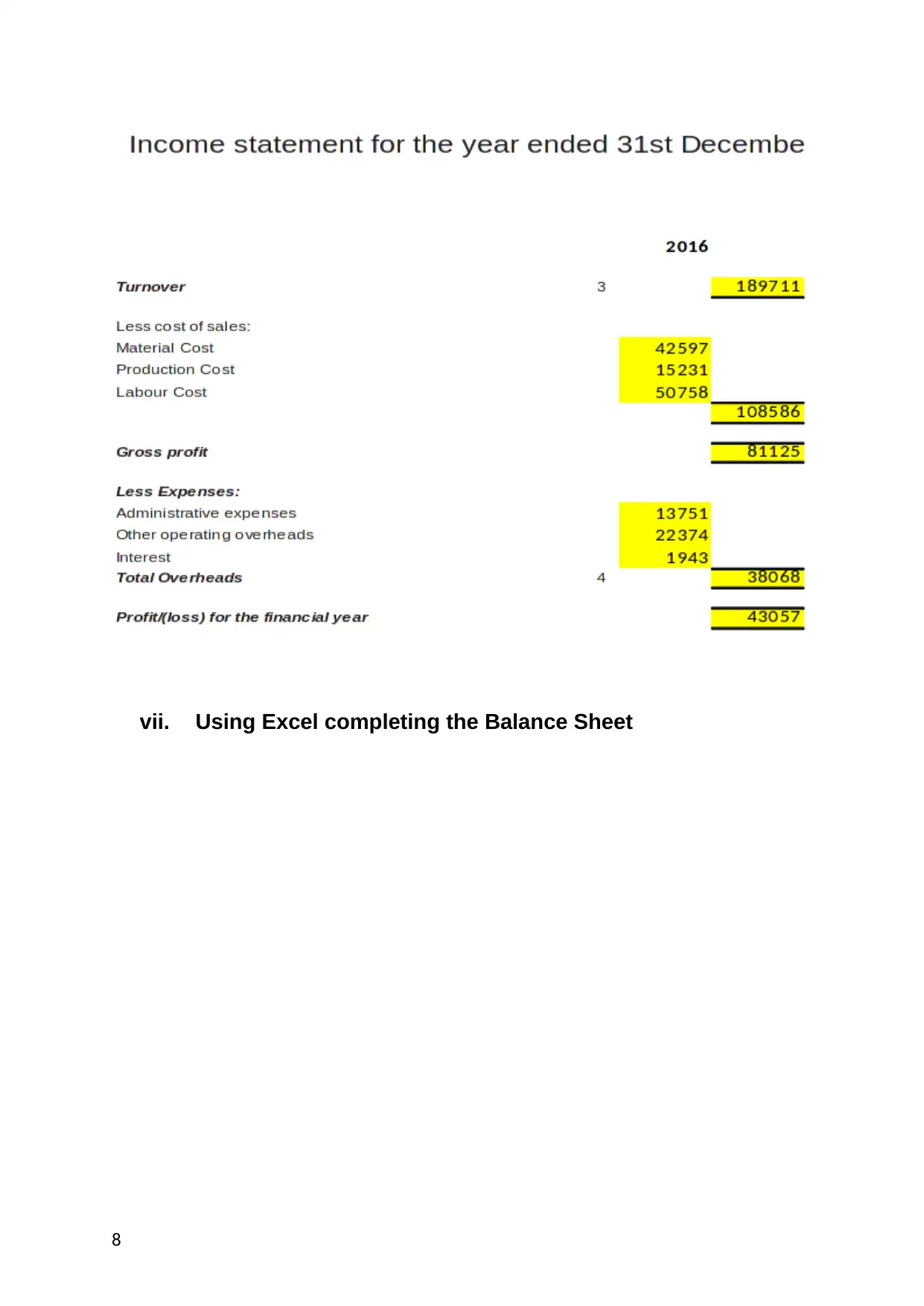
vii. Using Excel completing the Balance Sheet
8
8
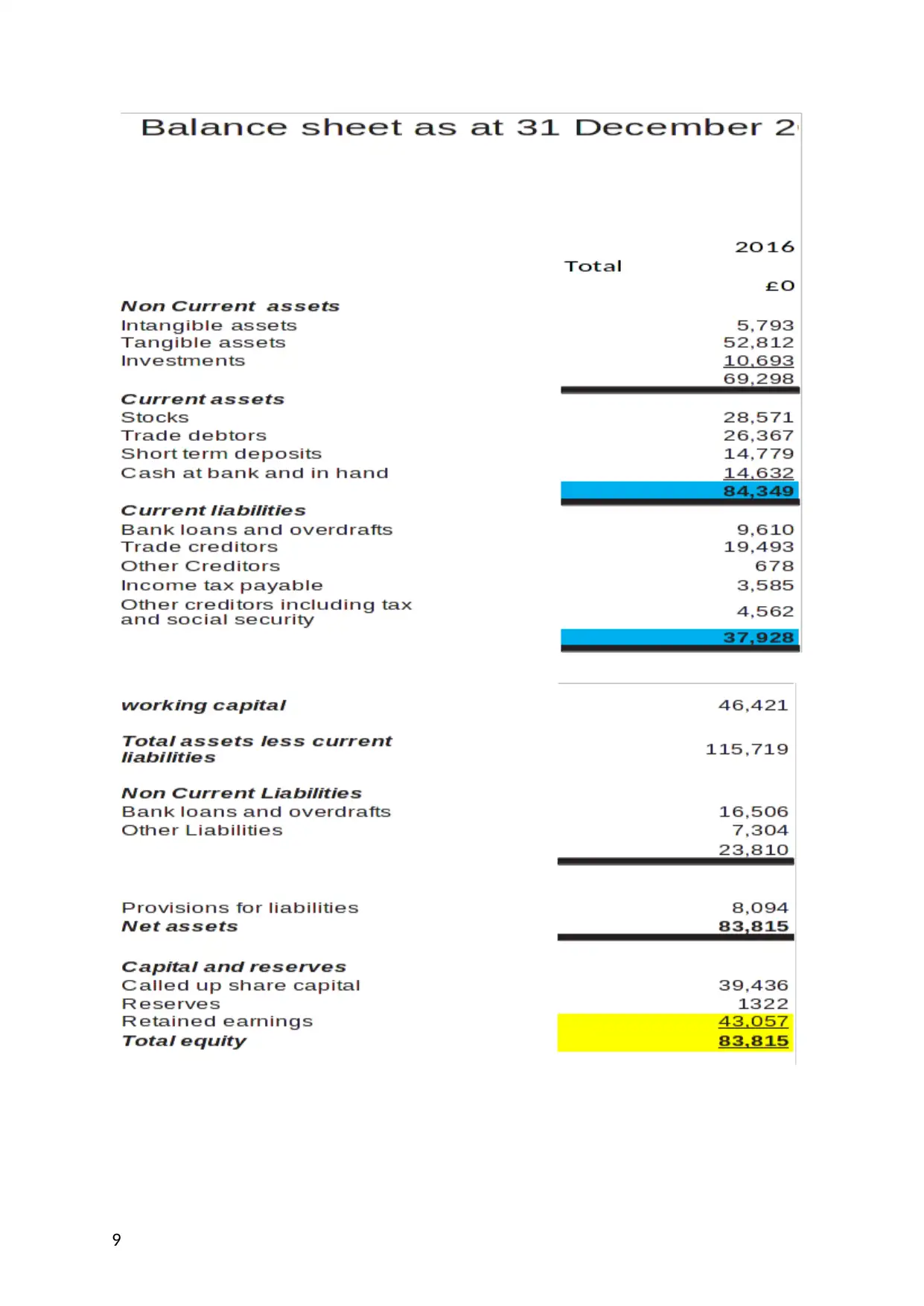
9
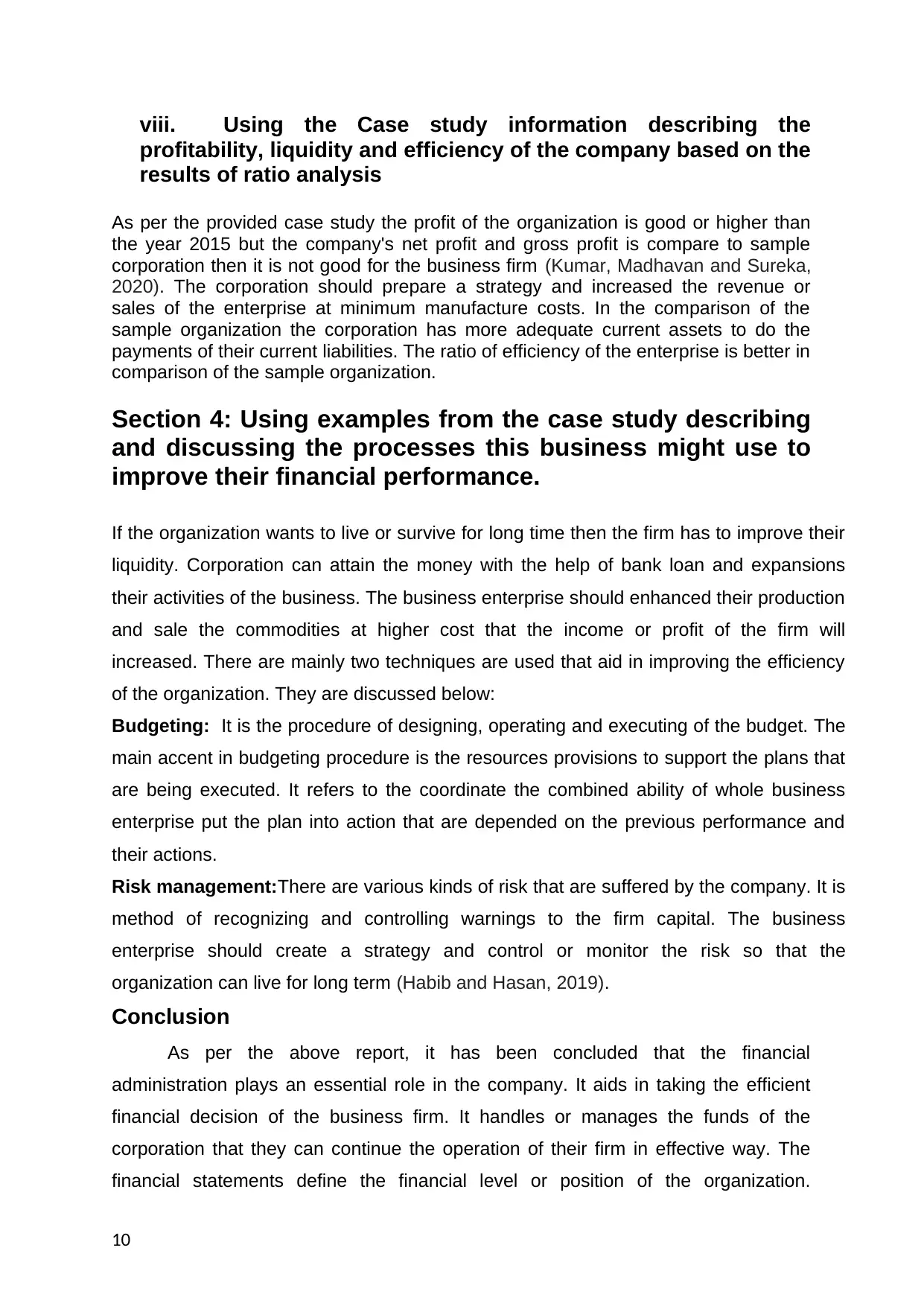
viii. Using the Case study information describing the
profitability, liquidity and efficiency of the company based on the
results of ratio analysis
As per the provided case study the profit of the organization is good or higher than
the year 2015 but the company's net profit and gross profit is compare to sample
corporation then it is not good for the business firm (Kumar, Madhavan and Sureka,
2020). The corporation should prepare a strategy and increased the revenue or
sales of the enterprise at minimum manufacture costs. In the comparison of the
sample organization the corporation has more adequate current assets to do the
payments of their current liabilities. The ratio of efficiency of the enterprise is better in
comparison of the sample organization.
Section 4: Using examples from the case study describing
and discussing the processes this business might use to
improve their financial performance.
If the organization wants to live or survive for long time then the firm has to improve their
liquidity. Corporation can attain the money with the help of bank loan and expansions
their activities of the business. The business enterprise should enhanced their production
and sale the commodities at higher cost that the income or profit of the firm will
increased. There are mainly two techniques are used that aid in improving the efficiency
of the organization. They are discussed below:
Budgeting: It is the procedure of designing, operating and executing of the budget. The
main accent in budgeting procedure is the resources provisions to support the plans that
are being executed. It refers to the coordinate the combined ability of whole business
enterprise put the plan into action that are depended on the previous performance and
their actions.
Risk management:There are various kinds of risk that are suffered by the company. It is
method of recognizing and controlling warnings to the firm capital. The business
enterprise should create a strategy and control or monitor the risk so that the
organization can live for long term (Habib and Hasan, 2019).
Conclusion
As per the above report, it has been concluded that the financial
administration plays an essential role in the company. It aids in taking the efficient
financial decision of the business firm. It handles or manages the funds of the
corporation that they can continue the operation of their firm in effective way. The
financial statements define the financial level or position of the organization.
10
profitability, liquidity and efficiency of the company based on the
results of ratio analysis
As per the provided case study the profit of the organization is good or higher than
the year 2015 but the company's net profit and gross profit is compare to sample
corporation then it is not good for the business firm (Kumar, Madhavan and Sureka,
2020). The corporation should prepare a strategy and increased the revenue or
sales of the enterprise at minimum manufacture costs. In the comparison of the
sample organization the corporation has more adequate current assets to do the
payments of their current liabilities. The ratio of efficiency of the enterprise is better in
comparison of the sample organization.
Section 4: Using examples from the case study describing
and discussing the processes this business might use to
improve their financial performance.
If the organization wants to live or survive for long time then the firm has to improve their
liquidity. Corporation can attain the money with the help of bank loan and expansions
their activities of the business. The business enterprise should enhanced their production
and sale the commodities at higher cost that the income or profit of the firm will
increased. There are mainly two techniques are used that aid in improving the efficiency
of the organization. They are discussed below:
Budgeting: It is the procedure of designing, operating and executing of the budget. The
main accent in budgeting procedure is the resources provisions to support the plans that
are being executed. It refers to the coordinate the combined ability of whole business
enterprise put the plan into action that are depended on the previous performance and
their actions.
Risk management:There are various kinds of risk that are suffered by the company. It is
method of recognizing and controlling warnings to the firm capital. The business
enterprise should create a strategy and control or monitor the risk so that the
organization can live for long term (Habib and Hasan, 2019).
Conclusion
As per the above report, it has been concluded that the financial
administration plays an essential role in the company. It aids in taking the efficient
financial decision of the business firm. It handles or manages the funds of the
corporation that they can continue the operation of their firm in effective way. The
financial statements define the financial level or position of the organization.
10
Secure Best Marks with AI Grader
Need help grading? Try our AI Grader for instant feedback on your assignments.

Company takes the decision by utilizing the income statement, balance sheet and
cash flow statement. In this report, there has been analyzed the financial ratio to
evaluate the performance of the financial of the firm and profitability ratio, net profit
and gross profit as well. The ratio of the efficiency presents that the corporation
capability to pay their liabilities of short term nature.
11
cash flow statement. In this report, there has been analyzed the financial ratio to
evaluate the performance of the financial of the firm and profitability ratio, net profit
and gross profit as well. The ratio of the efficiency presents that the corporation
capability to pay their liabilities of short term nature.
11
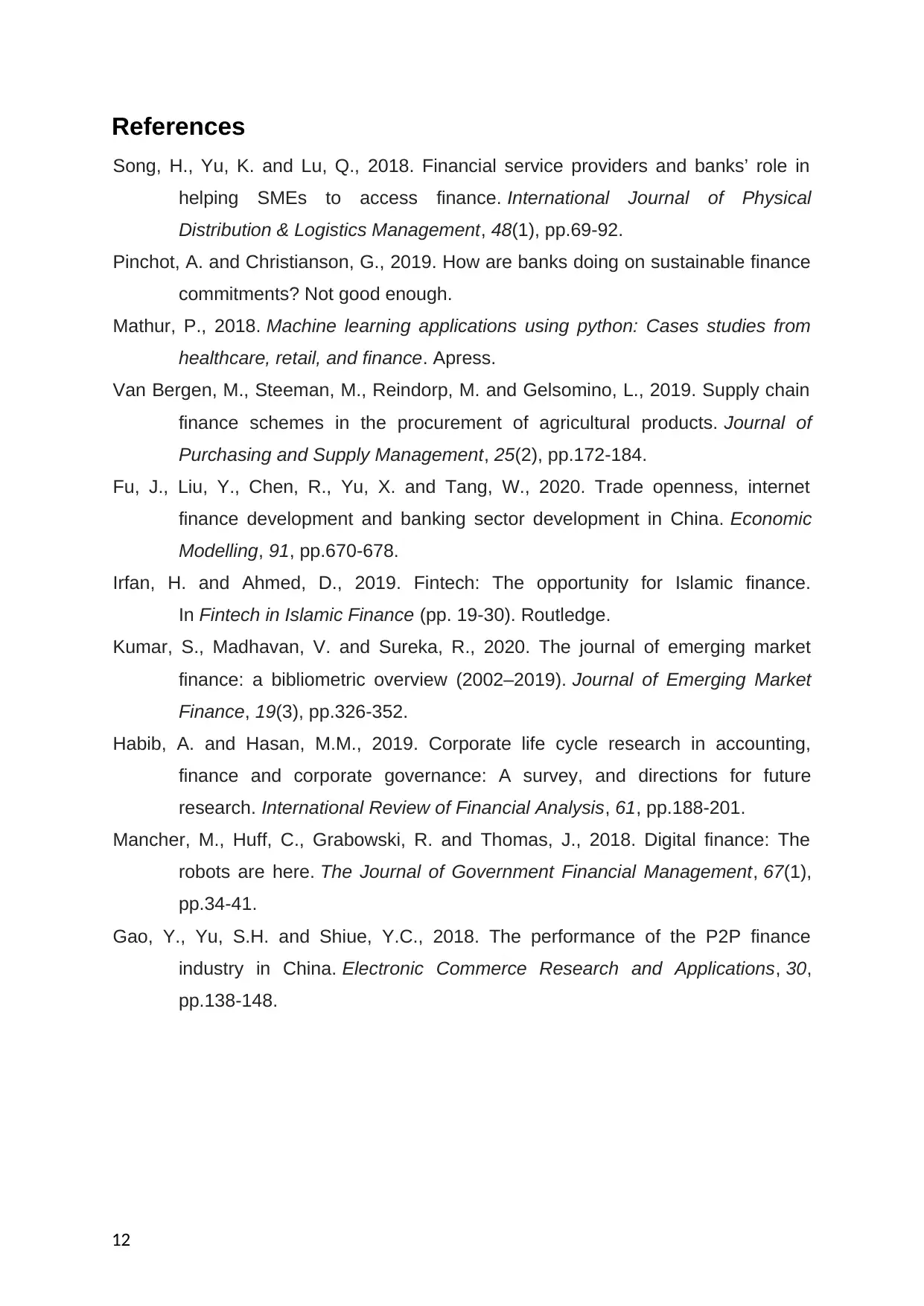
References
Song, H., Yu, K. and Lu, Q., 2018. Financial service providers and banks’ role in
helping SMEs to access finance. International Journal of Physical
Distribution & Logistics Management, 48(1), pp.69-92.
Pinchot, A. and Christianson, G., 2019. How are banks doing on sustainable finance
commitments? Not good enough.
Mathur, P., 2018. Machine learning applications using python: Cases studies from
healthcare, retail, and finance. Apress.
Van Bergen, M., Steeman, M., Reindorp, M. and Gelsomino, L., 2019. Supply chain
finance schemes in the procurement of agricultural products. Journal of
Purchasing and Supply Management, 25(2), pp.172-184.
Fu, J., Liu, Y., Chen, R., Yu, X. and Tang, W., 2020. Trade openness, internet
finance development and banking sector development in China. Economic
Modelling, 91, pp.670-678.
Irfan, H. and Ahmed, D., 2019. Fintech: The opportunity for Islamic finance.
In Fintech in Islamic Finance (pp. 19-30). Routledge.
Kumar, S., Madhavan, V. and Sureka, R., 2020. The journal of emerging market
finance: a bibliometric overview (2002–2019). Journal of Emerging Market
Finance, 19(3), pp.326-352.
Habib, A. and Hasan, M.M., 2019. Corporate life cycle research in accounting,
finance and corporate governance: A survey, and directions for future
research. International Review of Financial Analysis, 61, pp.188-201.
Mancher, M., Huff, C., Grabowski, R. and Thomas, J., 2018. Digital finance: The
robots are here. The Journal of Government Financial Management, 67(1),
pp.34-41.
Gao, Y., Yu, S.H. and Shiue, Y.C., 2018. The performance of the P2P finance
industry in China. Electronic Commerce Research and Applications, 30,
pp.138-148.
12
Song, H., Yu, K. and Lu, Q., 2018. Financial service providers and banks’ role in
helping SMEs to access finance. International Journal of Physical
Distribution & Logistics Management, 48(1), pp.69-92.
Pinchot, A. and Christianson, G., 2019. How are banks doing on sustainable finance
commitments? Not good enough.
Mathur, P., 2018. Machine learning applications using python: Cases studies from
healthcare, retail, and finance. Apress.
Van Bergen, M., Steeman, M., Reindorp, M. and Gelsomino, L., 2019. Supply chain
finance schemes in the procurement of agricultural products. Journal of
Purchasing and Supply Management, 25(2), pp.172-184.
Fu, J., Liu, Y., Chen, R., Yu, X. and Tang, W., 2020. Trade openness, internet
finance development and banking sector development in China. Economic
Modelling, 91, pp.670-678.
Irfan, H. and Ahmed, D., 2019. Fintech: The opportunity for Islamic finance.
In Fintech in Islamic Finance (pp. 19-30). Routledge.
Kumar, S., Madhavan, V. and Sureka, R., 2020. The journal of emerging market
finance: a bibliometric overview (2002–2019). Journal of Emerging Market
Finance, 19(3), pp.326-352.
Habib, A. and Hasan, M.M., 2019. Corporate life cycle research in accounting,
finance and corporate governance: A survey, and directions for future
research. International Review of Financial Analysis, 61, pp.188-201.
Mancher, M., Huff, C., Grabowski, R. and Thomas, J., 2018. Digital finance: The
robots are here. The Journal of Government Financial Management, 67(1),
pp.34-41.
Gao, Y., Yu, S.H. and Shiue, Y.C., 2018. The performance of the P2P finance
industry in China. Electronic Commerce Research and Applications, 30,
pp.138-148.
12
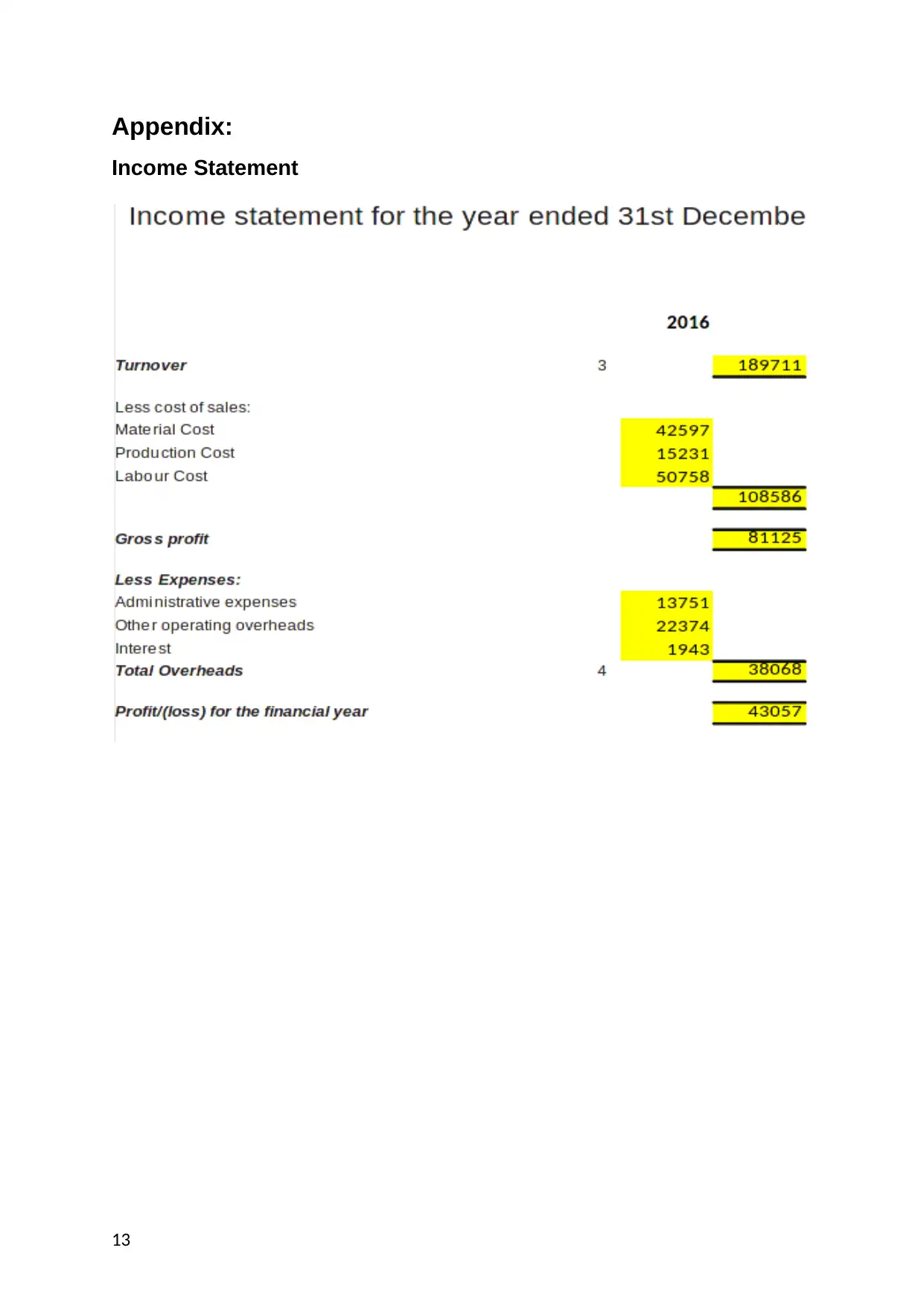
Appendix:
Income Statement
13
Income Statement
13
1 out of 13
Related Documents
Your All-in-One AI-Powered Toolkit for Academic Success.
+13062052269
info@desklib.com
Available 24*7 on WhatsApp / Email
![[object Object]](/_next/static/media/star-bottom.7253800d.svg)
Unlock your academic potential
© 2024 | Zucol Services PVT LTD | All rights reserved.


